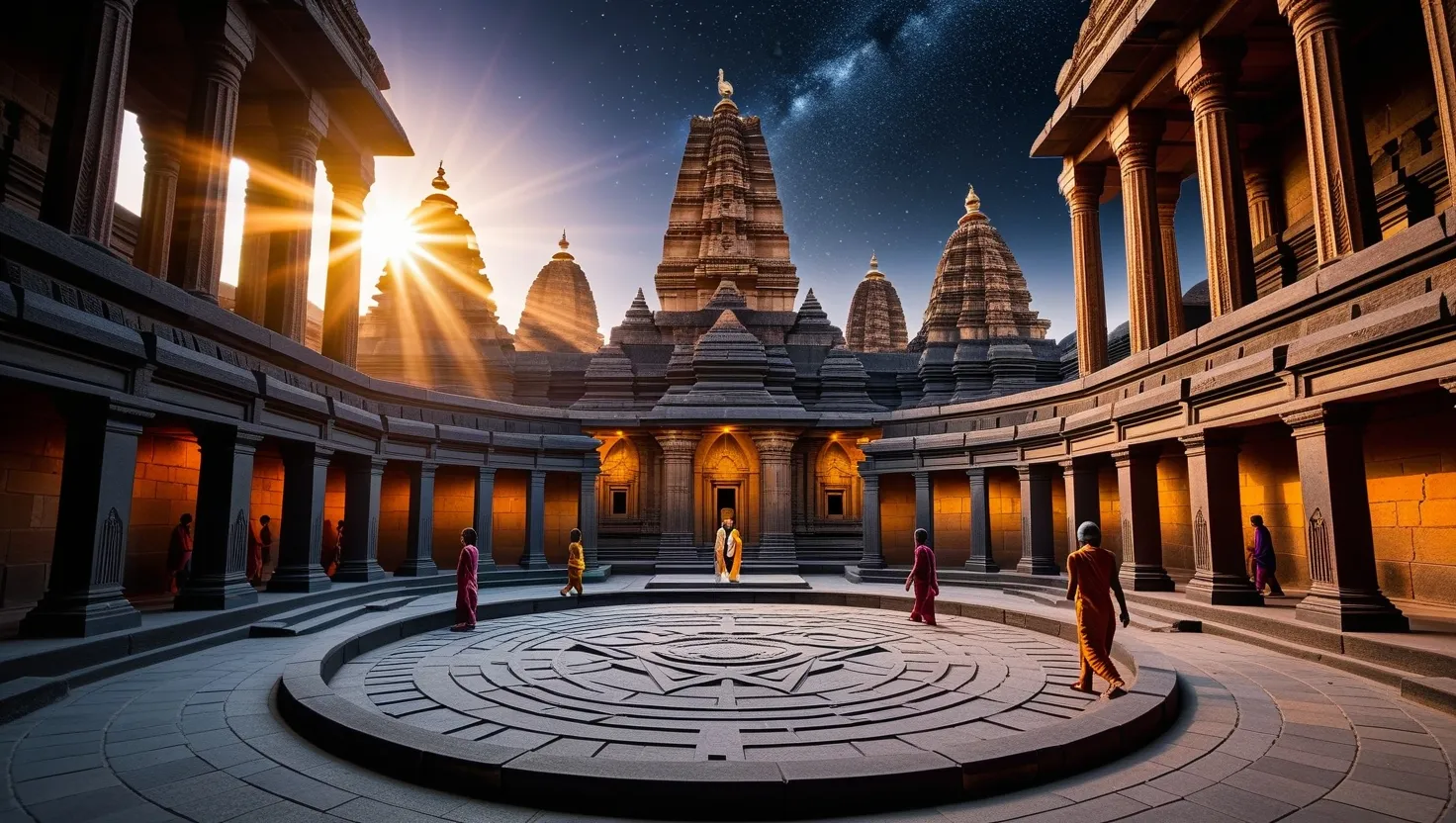If you’ve ever stepped into a Hindu temple and found yourself awed not just by its artistry but by the feeling of entering a world apart, you’re experiencing the effect of ancient design wisdom that goes beyond brick and stone. What may strike you as simply a place of worship is, in fact, a carefully engineered journey—a bridge joining the human body, the mind, and the fabric of the cosmos in a single living form.
I want you to imagine the temple as more than a building. Think of it as a body, a mind—your body, your mind—laid out in stone, light, and air. Ancient sages saw the universe as deeply connected to our inner worlds. They designed temples as mirrors; what you see in the sanctum, the hallways, and the soaring towers above is also present within you: heart, mind, breath, and spirit. Each element serves as an invitation to self-awareness and cosmic belonging.
At the core of this design is the Vastu Purusha Mandala, a geometric grid forming the bedrock of temple construction. The temple literally rises from the body of the ‘cosmic man,’ representing the universe and every living being. “The temple is the body of God. The sanctum is his head. The hall his heart.” It’s remarkable—the central chamber, called the garbhagriha, is always the womb or heart center, with the energy of the divine focused like the pulse of the cosmos. Around it, rings of space open and expand, echoing arteries and nerves, the spreading energy channels of a living organism.
Why do the towers above the sanctum always soar upward? They symbolize the head, the mind rising in search of higher wisdom. Even the temple’s gates are equated to the feet, grounding the experience in the earth as you begin your journey inward. Do you find yourself walking purposefully through a temple, step by step, feeling your attention narrow and your thoughts grow quiet? That’s precisely how the ancient architects wanted you to feel. Every threshold, every turn of the corridor, is designed to silent the senses, inviting you away from the everyday and toward the focused awareness at the temple’s center.
As Leonardo da Vinci once wrote, “The human foot is a masterpiece of engineering and a work of art.” In temples, even the progression through covered halls, open courtyards, and inner sanctuaries replicates our anatomy—a subtle lesson, reminding us of the temple within ourselves. The flagstaff, always standing before the sanctuary, represents the body’s axis, while the concentric walls mirror layers of the mind, from the distracted outer world to the unwavering focus of meditation.
But what makes this architecture so powerful is its relationship with numbers and geometry. Ratios between the temple’s dimensions are not just for aesthetics. They are meant to tune the physical structure to the rhythms of the universe—think of them like tuning a musical instrument, but instead of music, the aim is harmony with cosmic laws. The square, considered the most stable and perfect form, is the backbone; it radiates to form mandalas, each square carrying the essence of different deities, energies, or elements.
If you look up during a festival, notice how sunlight or moonlight enters a temple on very specific days, striking the deity or illuminating hidden chambers. Temples are aligned with the stars, the sun’s course, even planetary cycles. Builders went to great lengths, calculating, correcting, adjusting, so that, perhaps just for a few minutes each year, a shaft of light would reveal a deeper truth, connecting everyone present with cosmic time.
Have you wondered why the journey through a temple always seems to draw you inward, layer by layer? It’s no accident. The outermost walls often represent the noise of daily life, even hints of chaos. As you pass through each gate and hall, you move from distraction toward focus, from the human sphere towards the divine. The action is both a ritual and a psychological journey, subtly guiding your thoughts to become quieter, more attentive, as you approach the heart of the temple.
Carl Jung said, “Your vision will become clear only when you can look into your own heart. Who looks outside, dreams; who looks inside, awakes.” Standing in the silent darkness of a temple’s womb chamber, with light falling just right and incense swirling through cold stone, it’s easy to see what he meant. The design of the space itself facilitates not only devotion, but the kind of focused meditation that neuroscience now finds highly beneficial to the brain. Temples appear to have been unconsciously optimized for psychological transformation centuries before we had brain scans to prove it.
Modern research into sacred architecture suggests that such spaces encourage the brain to enter meditative, contemplative states. Low lighting, ambient sound from bells or chants, the gradual removal of external distractions—these elements all contribute to what scientists now call “altered states of consciousness,” associated with wellbeing and spiritual insight.
What I find fascinating is how practical this philosophy remains even in our concrete-and-glass world. Contemporary architects, when commissioned to build temples, sometimes return to these age-old diagrams and rituals, finding new ways to infuse technology with intentional symbolism. There are projects where digital sensors or glass walls are used to catch a solstice sunrise or to align modern life with ancient cycles, all while adhering to the mandala’s sacred geometry.
Why do these ideas endure? Perhaps because, at root, the temple’s purpose is not merely to honor divine beings, but to help us realize our fullest potential. The building doesn’t just point beyond itself toward gods somewhere far off, but inward to the universe we carry inside. “He who knows himself knows the universe and the gods,” declared the ancient maxim at Delphi.
During every festival or ritual, as pilgrims move around the sanctum, their actions mimic the journey of planets, stars, and the sun. The language of architecture fuses seamlessly with the rites—each pillar, each carving, each odd acoustical echo forming not just background, but an active part of the spiritual experience.
Take, for example, the use of the 64-square grid in so many famous temples. Each of these squares, according to older texts, is assigned an elemental force, a guardian spirit, or a planetary influence. As you circumambulate the sanctuary, you’re literally walking in the pattern of creation, with layers representing the spectrum of existence—from chaos at the boundaries to undisturbed purity at the center. Did you realize that even this circular walk, called pradakshina, is a meditation on the cycles of life and death?
One aspect that often goes overlooked is the play of light and shadow. Temples are not only built for rituals performed by priests, but for the drama of sunlight, moonlight, and firelight to chart their progress across the building each day, marking sacred times. I remember sitting in the pillared hall of an ancient temple in South India as the afternoon sun slanted through the carved windows, slowly lighting up statues shrouded in shade. That gradual shift becomes a kind of clock—a reminder that time and change are woven into the fabric of the universe.
It might surprise you that even the sounds within a temple are mapped out. Not just the reverberating chants or the ringing of bells, but the way sound echoes inside domes or fades into the open courtyards. The architecture is tuned—sometimes through centuries of trial and error—to amplify particular frequencies, heightening feelings of mystery and awe. If you listen closely, you can often hear your own breath merging with the omnipresent hymn.
“Architecture should speak of its time and place, but yearn for timelessness,” said Frank Gehry. Hindu temple design masters this rare balance. Each temple is of its land—built from local stone, decorated with regional stories—yet reaches far beyond, aspiring to big, cosmic truths.
Let’s consider the people for whom these temples were built. The master builders, known as shilpins, weren’t mere craftsmen. Many were initiates steeped in mathematics, astronomy, music, and philosophy. Their blueprints exist not just in stone and wood, but in religious texts filled with coded knowledge. A temple’s success is measured not simply by its beauty, but by its ability to bring people into contact with energies larger than themselves.
At the heart of this tradition lies a radical idea: that every human being is a microcosm of the universe. The sacred text Chandogya Upanishad puts it plainly: “Whatever exists in the universe exists in the body.” What does it mean to walk through a temple designed to remind you—at every turn, with every whisper of light and shadow and sound—that you are, in some important sense, the whole cosmos in miniature?
Today, as countless visitors flow through ancient and modern temples alike, the same questions echo: What is my place in the universe? How do the cycles of the sun and stars shape my days? What lies at the center of my being?
In the end, Hindu temple architecture invites us to stop seeking the divine only in distant skies. Instead, it shows us how the vastness of the cosmos is present right here—in our bodies, our thoughts, and every breath we take as we move through sacred space. The temple stands silent and patient, always ready to remind us: The journey without is, ultimately, the journey within.






